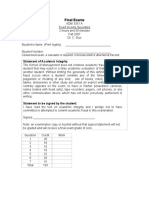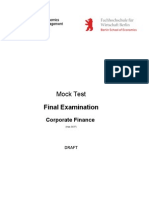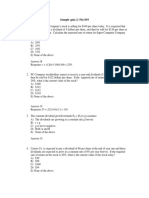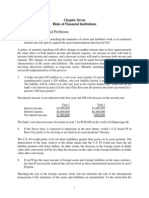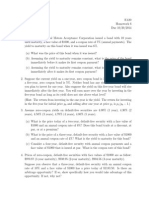Exercise C4
Uploaded by
Bruno Estanque ViegasExercise C4
Uploaded by
Bruno Estanque Viegas4.
Valuing Bonds
Bond cash flows, prices, and yields 4.1. A 30-year bond with a face value of $1000 has a coupon rate of 5.5%, with semiannual payments. a. What is the coupon payment for this bond? b. Draw the cash flows for the bond on a timeline. 4.2. Assume that a bond will make payments every six months as shown on the following timeline (using six-month periods):
a. What is the maturity of the bond (in years)? b. What is the coupon rate (in percent)? c. What is the face value? 4.3. The following table summarizes prices of various default-free, zero-coupon bonds (expressed as a percentage of face value): Maturity (years) Price (per $100 face value) 1 $95.51 2 $91.05 3 $86.38 4 $81.65 5 $76.51
a. Compute the yield to maturity for each bond. b. Plot the zero-coupon yield curve (for the first five years). c. Is the yield curve upward sloping, downward sloping, or flat? 4.4. Suppose the current zero-coupon yield curve for risk-free bonds is as follows: Maturity (years) YTM 1 5.00% 2 5.50% 3 5.75% 4 5.95% 5 6.05%
a. What is the price per $100 face value of a two-year, zero-coupon, risk-free bond? b. What is the price per $100 face value of a four-year, zero-coupon, risk-free bond? c. What is the risk-free interest rate for a five-year maturity?
4.5. Bloomberg.com reported that the three-month Treasury bill sold for a price of $100.002556 per $100 face value. What is the yield to maturity of this bond, expressed as an EAR? 4.6. Suppose a 10-year, $1000 bond with an 8% coupon rate and semiannual coupons is trading for a price of $1034.74. a. What is the bonds yield to maturity (expressed as an APR with semiannual compounding)? b. If the bonds yield to maturity changes to 9% APR, what will the bonds price be? 4.7. Suppose a five-year, $1000 bond with annual coupons has a price of $900 and a yield to maturity of 6%. What is the bonds coupon rate?
Dynamic behavior of bond prices 4.8. The prices of several bonds with face values of $1000 are summarized in the following table: Bond Price A $972.50 B $1040.75 C $1150.00 D $1000.00
a. For each bond, state whether it trades at a discount, at par, or at a premium. 4.9. Explain why the yield of a bond that trades at a discount exceeds the bonds coupon rate. 4.10. Suppose a seven-year, $1000 bond with an 8% coupon rate and semiannual coupons is trading with a yield to maturity of 6.75%. a. Is this bond currently trading at a discount, at par, or at a premium? Explain. b. If the yield to maturity of the bond rises to 7% (APR with semiannual compounding), what price will the bond trade for? 4.11. Suppose that General Motors Acceptance Corporation issued a bond with 10 years until maturity, a face value of $1000, and a coupon rate of 7% (annual payments). The yield to maturity on this bond when it was issued was 6%. a. What was the price of this bond when it was issued? b. Assuming the yield to maturity remains constant, what is the price of the bond immediately before it makes its first coupon payment? c. Assuming the yield to maturity remains constant, what is the price of the bond immediately after it makes its first coupon payment? 4.12. Suppose you purchase a 10-year bond with 6% annual coupons. You hold the bond for four years, and sell it immediately after receiving the fourth coupon. If the bonds yield to maturity was 5% when you purchased and sold the bond, a. What cash flows will you pay and receive from your investment in the bond per $100 face value? b. What is the internal rate of return of your investment? 4.13. Consider the following bonds: 2
Bond A B C D
Coupon rate (annual payments) 0% 0% 4% 8%
Maturity (years) 15 10 15 10
a. What is the percentage change in the price of each bond if its yield to maturity falls from 6% to 5%? b. Which of the bonds AD is most sensitive to a 1% drop in interest rates from 6% to 5% and why? Which bond is least sensitive? Provide an intuitive explanation for your answer. 4.14. Suppose you purchase a 30-year, zero-coupon bond with a yield to maturity of 6%. You hold the bond for five years before selling it. a. If the bonds yield to maturity is 6% when you sell it, what is the internal rate of return of your investment? b. If the bonds yield to maturity is 7% when you sell it, what is the internal rate of return of your investment? c. If the bonds yield to maturity is 5% when you sell it, what is the internal rate of return of your investment? d. Even if a bond has no chance of default, is your investment risk free if you plan to sell it before it matures? Explain. 4.15. Suppose you purchase a 30-year Treasury bond with a 5% annual coupon, initially trading at par. In 10 years time, the bonds yield to maturity has risen to 7% (EAR). a. If you sell the bond now, what internal rate of return will you have earned on your investment in the bond? b. If instead you hold the bond to maturity, what internal rate of return will you earn on your investment in the bond? c. Is comparing the IRRs in (a) versus (b) a useful way to evaluate the decision to sell the bond? Explain. 4.16. Suppose the current yield on a one-year, zero coupon bond is 3%, while the yield on a fiveyear, zero coupon bond is 5%. Neither bond has any risk of default. Suppose you plan to invest for one year. You will earn more over the year by investing in the five-year bond as long as its yield does not rise above what level?
The yield curve and bond arbitrage For problems 4.17-4.22, assume zero-coupon yields on default-free securities are as summarized in the following table: Maturity (years) Zero-coupon YTM 1 4.00% 2 4.30% 3 4.50% 5 4.70% 7 4.80%
4.17. What is the price today of a two-year, default-free security with a face value of $1000 and an annual coupon rate of 6%? Does this bond trade at a discount, at par, or at a premium? 4.18. What is the price of a five-year, zero-coupon, default-free security with a face value of $1000? 4.19. What is the price of a three-year, default-free security with a face value of $1000 and an annual coupon rate of 4%? What is the yield to maturity for this bond? 4.20. What is the maturity of a default-free security with annual coupon payments and a yield to maturity of 4%? Why? 4.21. Consider a four-year, default-free security with annual coupon payments and a face value of $1000 that is issued at par. What is the coupon rate of this bond? 4.22. Consider a five-year, default-free bond with annual coupons of 5% and a face value of $1000. a. Without doing any calculations, determine whether this bond is trading at a premium or at a discount. Explain. b. What is the yield to maturity on this bond? c. If the yield to maturity on this bond increased to 5.2%, what would the new price be? 4.23. Prices of zero-coupon, default-free securities with face values of $1000 are summarized in the following table: Maturity (years) Price (per $1000 face value) 1 $970.87 2 $938.95 3 $904.56
Suppose you observe that a three-year, default-free security with an annual coupon rate of 10% and a face value of $1000 has a price today of $1183.50. Is there an arbitrage opportunity? If so, show specifically how you would take advantage of this opportunity. If not, why not? 4.24. Assume there are four default-free bonds with the following prices and future cash flows: Bond A B C D Price today $934.58 $881.66 $1118.21 $839.62 Year 1 1000 0 100 0 4 Cash flows Year 2 0 1000 100 0
Year 3 0 0 1100 1000
Do these bonds present an arbitrage opportunity? If so, how would you take advantage of this opportunity? If not, why not? 4.25. Suppose you are given the following information about the default-free, coupon-paying yield curve: Maturity (years) Coupon rate (annual payments) YTM 1 0.00% 2.000% 2 10.00% 3.908% 3 6.00% 5.840% 4 12.00% 5.783%
a. Use arbitrage to determine the yield to maturity of a two-year, zero-coupon bond. b. What is the zero-coupon yield curve for years 1 through 4?
Corporate bonds (Not covered in Class. Covered in Section 8.4 in Berk and DeMarzo 2ed) 4.26. Explain why the expected return of a corporate bond does not equal its yield to maturity. 4.27. Grummon Corporation has issued zero-coupon corporate bonds with a five-year maturity. Investors believe there is a 20% chance that Grummon will default on these bonds. If Grummon does default, investors expect to receive only 50 cents per dollar they are owed. If investors require a 6% expected return on their investment in these bonds, what will be the price and yield to maturity on these bonds? 4.28. The following table summarizes the yields to maturity on several one-year, zero-coupon securities: Security Treasury AAA Corporate BBB Corporate B Corporate Yield (%) 3.1 3.2 4.2 4.9
a. What is the price (expressed as a percentage of the face value) of a one-year, zero-coupon corporate bond with a AAA rating? b. What is the credit spread on AAA-rated corporate bonds? c. What is the credit spread on B-rated corporate bonds? d. How does the credit spread change with the bond rating? Why? 4.29. Andrew Industries is contemplating issuing a 30-year bond with a coupon rate of 7% (annual coupon payments) and a face value of $1000. Andrew believes it can get a rating of A from Standard and Poors. However, due to recent financial difficulties at the company, Standard and Poors is warning that it may downgrade Andrew Industries bonds to BBB. Yields on Arated, long-term bonds are currently 6.5%, and yields on BBB-rated bonds are 6.9%. a. What is the price of the bond if Andrew maintains the A rating for the bond issue? 5
b. What will the price of the bond be if it is downgraded? 4.30. HMK Enterprises would like to raise $10 million to invest in capital expenditures. The company plans to issue five-year bonds with a face value of $1000 and a coupon rate of 6.5% (annual payments). The following table summarizes the yield to maturity for five-year (annualpay) coupon corporate bonds of various ratings: Rating YTM AAA 6.20% AA 6.30% A 6.50% BBB 6.90% BB 7.50%
a. Assuming the bonds will be rated AA, what will the price of the bonds be? b. How much total principal amount of these bonds must HMK issue to raise $10 million today, assuming the bonds are AA rated? (Because HMK cannot issue a fraction of a bond, assume that all fractions are rounded to the nearest whole number.) c. What must the rating of the bonds be for them to sell at par? d. Suppose that when the bonds are issued, the price of each bond is $959.54. What is the likely rating of the bonds? Are they junk bonds? 4.31. A BBB-rated corporate bond has a yield to maturity of 8.2%. A U.S. Treasury security has a yield to maturity of 6.5%. These yields are quoted as APRs with semiannual compounding. Both bonds pay semiannual coupons at a rate of 7% and have five years to maturity. a. What is the price (expressed as a percentage of the face value) of the Treasury bond? b. What is the price (expressed as a percentage of the face value) of the BBB-rated corporate bond? c. What is the credit spread on the BBB bonds? 4.32. The Isabelle Corporation rents prom dresses in its stores across the southern United States. It has just issued a five-year, zero-coupon corporate bond at a price of $74. You have purchased this bond and intend to hold it until maturity. a. What is the yield to maturity of the bond? b. What is the expected return on your investment (expressed as an EAR) if there is no chance of default? c. What is the expected return (expressed as an EAR) if there is a 100% probability of default and you will recover 90% of the face value? d. What is the expected return (expressed as an EAR) if the probability of default is 50%, the likelihood of default is higher in bad times than good times, and, in the case of default, you will recover 90% of the face value? e. For parts (bd), what can you say about the five-year, risk-free interest rate in each case?
You might also like
- Financial Markets and Institutions 9th Edition PDFNo ratings yetFinancial Markets and Institutions 9th Edition PDF15 pages
- Merchandising - Review Materials (Problems)No ratings yetMerchandising - Review Materials (Problems)65 pages
- FinMod 2022-2023 Tutorial 3 Exercise + AnswersNo ratings yetFinMod 2022-2023 Tutorial 3 Exercise + Answers39 pages
- Topic 3 Introduction To The Valuation of Fixed Income InstrumentsNo ratings yetTopic 3 Introduction To The Valuation of Fixed Income Instruments80 pages
- 3.1.2. If Gasoline Trades in A Competitive Market, Would A Transportation Company That Has A UseNo ratings yet3.1.2. If Gasoline Trades in A Competitive Market, Would A Transportation Company That Has A Use16 pages
- International Economics, 7e (Husted/Melvin) Chapter 3 The Classical Model of International TradeNo ratings yetInternational Economics, 7e (Husted/Melvin) Chapter 3 The Classical Model of International Trade25 pages
- Conceptual Framework: & Accounting Standards100% (1)Conceptual Framework: & Accounting Standards61 pages
- Chapter 008 Stock Valuation: Aacsb Topic: Analytic SECTION: 8.1 Topic: Stock Value Type: ProblemsNo ratings yetChapter 008 Stock Valuation: Aacsb Topic: Analytic SECTION: 8.1 Topic: Stock Value Type: Problems23 pages
- Topic 4 Yield Measures and The Yield Curves: FINA 4120 - Fixed Income 1No ratings yetTopic 4 Yield Measures and The Yield Curves: FINA 4120 - Fixed Income 173 pages
- PDF Accounting Business Reporting for Decision Making 6th Edition Birt Test Bank download100% (3)PDF Accounting Business Reporting for Decision Making 6th Edition Birt Test Bank download42 pages
- CHAPTER 5 Determination of Forward and Futures Prices: Multiple ChoiceNo ratings yetCHAPTER 5 Determination of Forward and Futures Prices: Multiple Choice21 pages
- Chapter 13 The Stock Market: Financial Markets and Institutions, 9e, Global Edition (Mishkin)No ratings yetChapter 13 The Stock Market: Financial Markets and Institutions, 9e, Global Edition (Mishkin)13 pages
- Lecture 21 ME Ch.15 Foreign Exchange MarketNo ratings yetLecture 21 ME Ch.15 Foreign Exchange Market50 pages
- Tutorial - Week 5-6 PS5 Solutions-UpdatedNo ratings yetTutorial - Week 5-6 PS5 Solutions-Updated6 pages
- Multinational Business Finance 13th Edition Eiteman Stonehill Moffett Test BankNo ratings yetMultinational Business Finance 13th Edition Eiteman Stonehill Moffett Test Bank16 pages
- Immediate download Investment Analysis and Portfolio Management Reilly 10th Edition Solutions Manual all chapters100% (7)Immediate download Investment Analysis and Portfolio Management Reilly 10th Edition Solutions Manual all chapters50 pages
- Chapter 3 International Financial MarketNo ratings yetChapter 3 International Financial Market13 pages
- 01 Alternative Investments For Portfolio Management1No ratings yet01 Alternative Investments For Portfolio Management134 pages
- Chapter 001 A Brief History of Risk and Return: Multiple Choice QuestionsNo ratings yetChapter 001 A Brief History of Risk and Return: Multiple Choice Questions43 pages
- Free Access to Test Bank for Essentials of Investments, 11th Edition, Zvi Bodie, Alex Kane, Alan Marcus, ISBN10: 1260013928, ISBN13: 9781260013924 Chapter Answers100% (6)Free Access to Test Bank for Essentials of Investments, 11th Edition, Zvi Bodie, Alex Kane, Alan Marcus, ISBN10: 1260013928, ISBN13: 9781260013924 Chapter Answers56 pages
- Chapter 21 The Monetary Policy and Aggregate Demand CurvesNo ratings yetChapter 21 The Monetary Policy and Aggregate Demand Curves7 pages
- Reading 1 The Behavioral Biases of IndividualsNo ratings yetReading 1 The Behavioral Biases of Individuals7 pages
- Chapter Questions and Problems: Chapter Seven Risks of Financial InstitutionsNo ratings yetChapter Questions and Problems: Chapter Seven Risks of Financial Institutions2 pages
- Chapter 1 Accruals and Prepayments: RequiredNo ratings yetChapter 1 Accruals and Prepayments: Required28 pages
- Chapter-04-Long-Term Liabilities-1(1)(1)No ratings yetChapter-04-Long-Term Liabilities-1(1)(1)5 pages
- CSUSB Syllabus Fin 3002 Shelton Fall 2021 Section 61 ONLINENo ratings yetCSUSB Syllabus Fin 3002 Shelton Fall 2021 Section 61 ONLINE12 pages
- Intermediate Accounting Chapter 3 ProblemsNo ratings yetIntermediate Accounting Chapter 3 Problems34 pages
- Subject CM1 Actuarial Mathematics Core Principles Syllabus: For The 2019 ExamsNo ratings yetSubject CM1 Actuarial Mathematics Core Principles Syllabus: For The 2019 Exams12 pages
- Equity Valuation & Analysis-Bhargav Buddhadev-06No ratings yetEquity Valuation & Analysis-Bhargav Buddhadev-0644 pages
- Unit 1 Introduction To Software Project Management Software DefinitionNo ratings yetUnit 1 Introduction To Software Project Management Software Definition23 pages
- Analysis of Notes Receivable and Related AccountsqNo ratings yetAnalysis of Notes Receivable and Related Accountsq5 pages
- Chapter 2. Economic Analysis of Water ResourcesNo ratings yetChapter 2. Economic Analysis of Water Resources74 pages
- Financial Management of Projects and Contracts Lecture 1No ratings yetFinancial Management of Projects and Contracts Lecture 137 pages
- Financial Markets and Institutions 9th Edition PDFFinancial Markets and Institutions 9th Edition PDF
- Topic 3 Introduction To The Valuation of Fixed Income InstrumentsTopic 3 Introduction To The Valuation of Fixed Income Instruments
- 3.1.2. If Gasoline Trades in A Competitive Market, Would A Transportation Company That Has A Use3.1.2. If Gasoline Trades in A Competitive Market, Would A Transportation Company That Has A Use
- International Economics, 7e (Husted/Melvin) Chapter 3 The Classical Model of International TradeInternational Economics, 7e (Husted/Melvin) Chapter 3 The Classical Model of International Trade
- Chapter 008 Stock Valuation: Aacsb Topic: Analytic SECTION: 8.1 Topic: Stock Value Type: ProblemsChapter 008 Stock Valuation: Aacsb Topic: Analytic SECTION: 8.1 Topic: Stock Value Type: Problems
- Topic 4 Yield Measures and The Yield Curves: FINA 4120 - Fixed Income 1Topic 4 Yield Measures and The Yield Curves: FINA 4120 - Fixed Income 1
- PDF Accounting Business Reporting for Decision Making 6th Edition Birt Test Bank downloadPDF Accounting Business Reporting for Decision Making 6th Edition Birt Test Bank download
- CHAPTER 5 Determination of Forward and Futures Prices: Multiple ChoiceCHAPTER 5 Determination of Forward and Futures Prices: Multiple Choice
- Chapter 13 The Stock Market: Financial Markets and Institutions, 9e, Global Edition (Mishkin)Chapter 13 The Stock Market: Financial Markets and Institutions, 9e, Global Edition (Mishkin)
- Multinational Business Finance 13th Edition Eiteman Stonehill Moffett Test BankMultinational Business Finance 13th Edition Eiteman Stonehill Moffett Test Bank
- Immediate download Investment Analysis and Portfolio Management Reilly 10th Edition Solutions Manual all chaptersImmediate download Investment Analysis and Portfolio Management Reilly 10th Edition Solutions Manual all chapters
- 01 Alternative Investments For Portfolio Management101 Alternative Investments For Portfolio Management1
- Chapter 001 A Brief History of Risk and Return: Multiple Choice QuestionsChapter 001 A Brief History of Risk and Return: Multiple Choice Questions
- Free Access to Test Bank for Essentials of Investments, 11th Edition, Zvi Bodie, Alex Kane, Alan Marcus, ISBN10: 1260013928, ISBN13: 9781260013924 Chapter AnswersFree Access to Test Bank for Essentials of Investments, 11th Edition, Zvi Bodie, Alex Kane, Alan Marcus, ISBN10: 1260013928, ISBN13: 9781260013924 Chapter Answers
- Chapter 21 The Monetary Policy and Aggregate Demand CurvesChapter 21 The Monetary Policy and Aggregate Demand Curves
- Chapter Questions and Problems: Chapter Seven Risks of Financial InstitutionsChapter Questions and Problems: Chapter Seven Risks of Financial Institutions
- CSUSB Syllabus Fin 3002 Shelton Fall 2021 Section 61 ONLINECSUSB Syllabus Fin 3002 Shelton Fall 2021 Section 61 ONLINE
- Subject CM1 Actuarial Mathematics Core Principles Syllabus: For The 2019 ExamsSubject CM1 Actuarial Mathematics Core Principles Syllabus: For The 2019 Exams
- Unit 1 Introduction To Software Project Management Software DefinitionUnit 1 Introduction To Software Project Management Software Definition
- Analysis of Notes Receivable and Related AccountsqAnalysis of Notes Receivable and Related Accountsq
- Financial Management of Projects and Contracts Lecture 1Financial Management of Projects and Contracts Lecture 1













